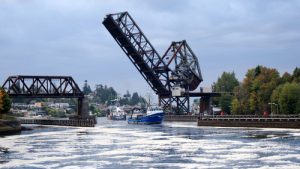Hiram M. Chittenden Locks
Check Out Hiram M. Chittenden Locks
Seattle’s Hiram M. Chittenden Locks has been a crowd-puller ever since it first opened all the way back in 1917. During the summer months, in particular, the lockside is mobbed by people. All of whom are eager to catch a glimpse of the engineering marvel at work. And, make no mistake about it, Hiram M. Chittenden Locks is most certainly a marvel.
A Little Background Info on Hiram M. Chittenden Locks
The locks link the tidal waters of Puget Sound to Lake Union and Lake Washington via the Lake Washington Ship Canal. Okay so on its own that doesn’t sound too impressive. Or at least it doesn’t until you learn that the locks prevent saltwater seeping into, and thereby damaging, fragile freshwater ecosystems and that the height difference between the separate waterways can measure up to 26 ft.
Now, bear in mind that everything from diminutive kayaks to hulking cargo ships makes use of these locks. As hardly needs to be stated, lifting a bulky cargo ship 26ft takes quite some doing. Indeed, such a feat would have been all but impossible, if the locks’ eponymous engineer, Hiram M. Chittenden, had stuck with the tried and trusted construction methods of the early 20th century. Luckily, however, Chittenden was no kowtower to popular conventions. If anything, in lock-building terms, he was actually something of a radical.
Seen through a modern lens, Chittenden’s unwavering insistence that steel and concrete were the only materials fit for the job, may seem altogether uncontroversial. A logical choice for the job at hand, you may think. However, at the time, his stance marked quite a significant departure from mainstream thinking on engineering.
Needless to say, the locks’ long-running success has more than vindicated Chittenden’s unorthodox approach. To this day, more than a hundred years after their opening, the locks remain the busiest in the United States. Each year, in fact, as many as 50,000 vessels make use of Chittenden’s engineering masterpiece. Granted, the locks, which were originally envisioned to serve principally as economic arteries, are today mostly used by a varied array of pleasure crafts. But, even still, echoes of their industrial heritage live on. A large chunk of the Alaskan fishing fleet, for example, pass through annually on their way to moor at the nearby Fisherman’s Terminal.
Visitor Center & Botanical Gardens
The visitor center is awash with exhibits on the engineering innovations behind the locks’ construction. The Carl S. English Jr. Botanical Gardens, meanwhile, bring a parkland vibe to the otherwise largely industrial surroundings.
The Fish Ladder
A 21-step fish ladder helps salmon as well as other species to successfully navigate the locks before heading further upstream to spawn. What’s more, an underground viewing gallery offers visitors the best seats in the house to watch this spectacular aquatic migration unfold. As if that wasn’t enough, a slew of engaging exhibits explains all you need to know about the locks’ fish species.
Free Tours
No, you didn’t read that wrong. There really are free tours. During high season (May to September), these hour-long tours leave daily from the visitor center. On weekdays there are two scheduled tours. One at 1 pm, the other at 3 pm. While at weekends, an additional third tour leaves at 11 am. Between October and April, tours run at 2 pm between Thursday and Monday.
The free tours take a winter break for the duration of December, January, and February.

